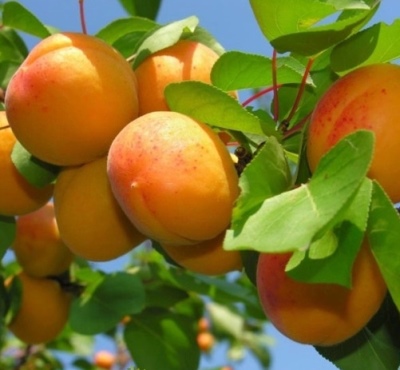
- Authors: A.K. Skvortsov, L.A. Kramarenko (Main Botanical Garden named after N.V. Tsitsin RAS)
- Year of approval: 2004
- Tree height, m: 3
- Escapes: straight, dark red, glabrous, highly branched
- Flowers: large, white
- Fruit weight, g: 20-22
- Fruit shape: round or oval, laterally flattened
- Skin : thin, pubescent, with little or no dotted blush
- Fruit color: yellow-orange
- Pulp color : yellow-orange
Apricot Iceberg is an unpretentious variety that is distinguished not only by tasty fruits. The culture is early-growing, allowing you to eat the first apricots just a few years after planting. In addition, the plant is frost-resistant, which can be cultivated even in the conditions of the Moscow region.
Description of the variety
Medium compact tree. The maximum apricot height is 3 m, which is ideal for small backyards. The crown is not very dense, slightly raised. Straight, highly branched shoots of a dark red hue require mandatory pruning. The leaf plate is wide, ovoid, short-pointed. The leaves are smooth, shiny, dark green in color. The flowers are large, 4 cm in diameter, white.
Fruit characteristics
Large-fruited variety. The shape of the fruit is predominantly round, slightly flattened on the sides. The average weight of one fruit is 20-22 g. The color of ripe fruits is yellow-orange, sometimes with a slight dotted blush. Thin skin with slight drooping. The small bone is easily separated from the pulp. The fruits have good keeping quality.
Taste qualities
Iceberg's yellow-orange pulp has a delicious sweet and sour taste, rich aroma due to the balanced composition of the fruits. Apricot is rich in potassium (360 mg / 100 g), fruit acids (1.9%). Dry matter - 15.3%. The consistency of the pulp is of medium density, tender and rather juicy, melting in the mouth. Tasting score 4 points out of 5. Fruit is consumed both fresh and processed.
Ripening and fruiting
The plant is fast-growing, with an early maturity. Begins fruiting in 3-4 years. Fruiting on all types of shoots. Blossoms in May; fruit ripens in late July - early August.

Yield
High-yielding hybrid. On average, 48 centners of fruits are harvested from one hectare.
Growing regions
The variety reveals its fruitful abilities to the maximum when grown in the Central region of Russia.
Self-fertility and the need for pollinators
Partially self-fertile. Plant a compatible pollinator near the tree to increase the yield. The varieties Tsarsky, Alyosha and Lel do well with this role.
Growing and care
The iceberg needs the most illuminated place for proper development. The tree is not able to put up with even a slight partial shade, because of it the fruits become smaller and significantly lose quality in taste. Also, the site must be protected from cold winds.
It grows well on sandy loam and loamy soils with an acidity level not higher than 7. The soil should be loose and breathable, with deep groundwater.
Landing depends on the climatic conditions of the region. The optimal time for planting is spring, after the threat of night frosts has passed. As a rule, this is the end of April. In the southern regions, trees can also be planted in autumn (late September - early October).
The choice of planting material must be approached with the utmost seriousness, since the future harvest depends on the quality of the seedlings.Saplings are best purchased from nurseries. One should choose annual specimens without signs of damage and disease, dry shoots, with a well-developed root system. If it is possible to purchase a seedling with closed roots, then give preference to it. Such trees quickly adapt, tolerate transplantation painlessly.
Before you plant an Iceberg on your site, it is preliminarily prepared. Thoroughly dig up the soil, removing weeds and applying mineral and organic fertilizers. If a spring planting is planned, the hole is prepared in the fall, but organic matter is added a month before planting. For autumn planting, the hole is prepared in 20 days.
The planting pattern between the plants is 5X5 m. The planting hole is dug with a diameter of 70–80 cm, up to 50 cm deep. Sand and peat are added to the soil in equal amounts, and the soil is also enriched with rotted manure, potassium, phosphorus, nitrogen.
A drainage layer is laid at the bottom of the pit, then a nutritious soil mixture is poured in a slide, on which a seedling pre-soaked for several hours is installed. The remaining soil is poured into the plant to the grafting site, then it is watered abundantly. When the soil settles a little, you need to add more soil and lay a layer of mulch around the plant.
Further care for the apricot consists in proper watering, especially during the period of flowering and fruit formation. It should be rare but abundant. Sanitary and molding trims are carried out in spring and autumn. Damaged, dry, frozen, infected shoots are removed.



Disease and pest resistance
With competent agricultural technology, the plant is practically not susceptible to attack by pests and is not affected by infectious diseases. Unstable weather conditions and improper cultivation can lead to the development of moniliosis, bacterial spotting, clotterosporia and aphid infestation. Fungicides cope well with diseases.
































































